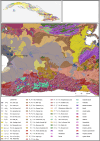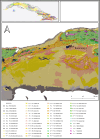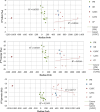Diversity of Lifeways in Early Antillean Societies: A Multi-Isotope Approach
- PMID: 40241353
- PMCID: PMC12003967
- DOI: 10.1002/ajpa.70039
Diversity of Lifeways in Early Antillean Societies: A Multi-Isotope Approach
Abstract
Objectives: In this paper, we sought to examine whether people with different lifeways, as evidenced by their mobility patterns and dietary practices, inhabited the Antilles in early precolonial time. We also aimed to explore spatiotemporal trends.
Materials and methods: New and previously published enamel strontium, oxygen, and carbon isotope data were combined with bone apatite carbon and bone collagen carbon and nitrogen isotope data to assess the mobility and diet of 146 individuals from eight early precolonial sites from Cuba.
Results: At least three patterns of mobility, associated with different dietary signals, were identified. In contrast with the low 87Sr/86Sr and δ13Cen variability found in Canímar Abajo (CA) between bce 1320 and 807, more variability in dietary practices and higher mobility was apparent in later groups. Between bce 116 and 241 ce, individuals from Playa del Mango showed high mobility within the Cauto region, likely associated with food procurement between inland and coastal areas. From at least 174 ce, a moderate pattern of mobility and a diversity of dietary traditions could be observed among groups from western sites. At least three general dietary patterns were observed, ranging from a 100% C3 diet to 70:30 C3/C4 and, in the case of CA, a higher dependence on marine/C4 resources.
Conclusions: The differences observed in both mobility and diet between and within populations support the notion that groups with different lifeways inhabited the Antilles in precolonial times. This diverse mosaic of cultural traits defies attempts to group them into broad categories for regional studies of biological and cultural traits.
Keywords: Caribbean Archaic; diversity of lifeways; paleodiet; paleomobility; stable isotopes.
© 2025 The Author(s). American Journal of Biological Anthropology published by Wiley Periodicals LLC.
Conflict of interest statement
The authors declare no conflicts of interest.
Figures







Similar articles
-
Earliest evidence of sedentism in the Antilles: Multiple isotope data from Canímar Abajo, Cuba.Proc Natl Acad Sci U S A. 2025 Jan 7;122(1):e2413963121. doi: 10.1073/pnas.2413963121. Epub 2024 Dec 23. Proc Natl Acad Sci U S A. 2025. PMID: 39715435 Free PMC article.
-
Stable isotope analysis of a pre-Hispanic Andean community: Reconstructing pre-Wari and Wari era diets in the hinterland of the Wari empire, Peru.Am J Phys Anthropol. 2018 Jan;165(1):149-172. doi: 10.1002/ajpa.23339. Epub 2017 Oct 26. Am J Phys Anthropol. 2018. PMID: 29072312
-
Multi-tissue stable carbon and nitrogen isotope models for dietary reconstruction: Evaluation using a southern African farming population.Am J Phys Anthropol. 2019 Jan;168(1):145-153. doi: 10.1002/ajpa.23731. Epub 2018 Oct 31. Am J Phys Anthropol. 2019. PMID: 30379328
-
Reconstructing prehistoric lifeways using multi-Isotope analyses of human enamel, dentine, and bone from Legaire Sur, Spain.PLoS One. 2025 Jan 22;20(1):e0316387. doi: 10.1371/journal.pone.0316387. eCollection 2025. PLoS One. 2025. PMID: 39841628 Free PMC article.
-
Exploring imperial expansion using an isotopic analysis of paleodietary and paleomobility indicators in Chachapoyas, Peru.Am J Phys Anthropol. 2017 Jan;162(1):51-72. doi: 10.1002/ajpa.23085. Epub 2016 Sep 15. Am J Phys Anthropol. 2017. PMID: 27627862
References
-
- Alonso, E. , Izquierdo G., González U. M., Hernández G., Valcárcel R., and Blanco E.. 2015. Las comunidades aborígenes en la Historia de Cuba. Fundación Fernando Ortiz.
-
- Bataille, C. P. , Laffoon J. E., and Bowen G. J.. 2012. “Mapping Multiple Source Effects on the Strontium Isotopic Signatures of Ecosystems From the Circum Caribbean Region.” Ecosphere 3, no. 12: 1–24. 10.1890/ES12-00155.1. - DOI
-
- Bayon, G. , Freslon N., Germain Y., Bindeman I. N., Trinquier A., and Barrat J. A.. 2021. “A Global Survey of Radiogenic Strontium Isotopes in River Sediments.” Chemical Geology 559: 119958. 10.1016/j.chemgeo.2020.119958. - DOI
-
- Bentley, A. R. 2006. “Strontium Isotopes From the Earth to the Archaeological Skeleton: A Review.” Journal of Archaeological Method and Theory 13, no. 3: 135–187. 10.1007/s10816-006-9009-x. - DOI
-
- Bocherens, H. , Sandrock O., Kullmer O., and Schrenk F.. 2011. “Hominin Palaeoecology in Late Pliocene Malawi: First Insights From Isotopes (13C, 18O) in Mammal Teeth.” South African Journal of Science 107, no. 3–4: 1–6. 10.4102/sajs.v107i3/4.331. https://sajs.co.za/article/view/10060. - DOI
Publication types
MeSH terms
Substances
Grants and funding
LinkOut - more resources
Full Text Sources
Research Materials
Miscellaneous
